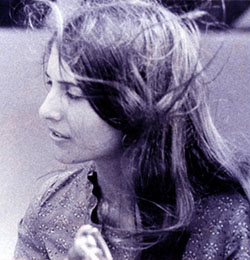
|
Mimi Fariña A biography of the great guitarist, singer, songwriter & humanitarian 
|

|
Mimi Fariña A biography of the great guitarist, singer, songwriter & humanitarian 
|
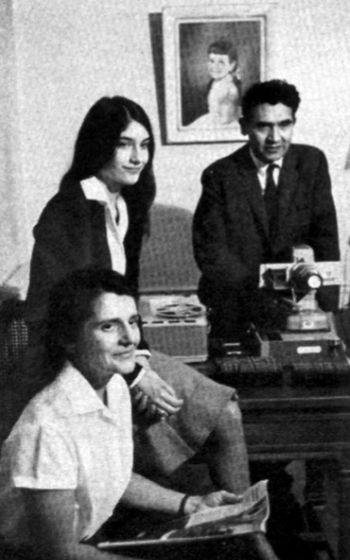
Mimi with her parents, from Time Magazine, Nov. 1962. |
Margarita Mimi Baez was born in Palo Alto, California on April 30, 1945,
the third daughter of Albert and Joan Bridge Baez. The oldest daughter, Pauline,
was six years older than Mimi, and Joan was four years older than Mimi. Both
parents were first-generation
immigrants, her father coming from Mexico and her mother from Scotland. The family
moved frequently while Albert pursued a career
in physics, first as a graduate student then as a professor. They ran a
boarding house for two years while Albert studied at Stanford, then they moved to
Redlands when he took a job as a teaching assistant there.
In 1949 Albert accepted his first professional post as an experimental
physicist at Cornell University in Ithaca, NY. The family moved across the country
to the small town of Clarence Center, halfway between Ithaca and Buffalo. It was
here that Mrs. Baez introduced the family to the Quaker religion and they began attending
meetings at the Religious Society of Friends. Mrs. Baez had no great faith in
organized religion, having attended a Quaker school in her childhood, she felt
that their ethical teachings, specifically their
abnegation of violence, would help guide Albert's struggle with the moral
dilemmas of his chosen field as the United States began developing nuclear weapons.
In 1951 Unesco offered Albert a one-year position in Baghdad teaching physics,
building a laboratory, and initiating research. Off they went to the land
of a Thousand and One Nights. Their year in Baghdad proved to be an unforgettable
ordeal of squalor and poverty and unbearable heat. It was a trial for the entire
family but was particularly
traumatic for Mimi, who was only six at the time. She was placed in a one-room
school of the Catholic Convent with Pauline (Joan was sick with hepatitis and did not have to
attend) and was expected to perform at the level of the older children. Although
she learned to speak Arabic on her own, she had not yet learned to read
and write in English. She was humiliated by a cruel teacher named Sister Rose, who,
Albert Baez believes, choked the joy of reading out of Mimi. It was an immense
relief when his year-long assignment ended the family moved back to California,
though years later they would all agree that the experience had a profound impact
on their lives.
Mrs. Baez compensated for their frequent moving and irregular education by making
sure that, no matter where they lived, Mimi was
always connected to creativity through music or dance lessons. Mimi's earliest
enthusiasm was for dancing. "She learned to dance almost before she learned to walk,"
Joan recalled. All three Baez sisters learned instruments as children. Joan and
Pauline took up the ukelele and Mimi played violin.
In the Spring of 1962 many folksingers happened to be in Paris for an overseas
stomp--there was a brief vogue of expatriatism--so one day in early April they all went on a
picnic together in the countryside and visited
Chartres Cathedral. In attendance were Mimi, her friend Todd Stuart,
John Cooke of the Charles River Valley Boys, English guitarist Alex Campbell,
Texas folksinger Carolyn Hester, and Carolyn's husband Richard Fariña, who
had planned the picnic. Mimi was to learn later that Richard Fariña planned many
picnics, parties, and happenings. He was a writer and poet,
eight years older than Mimi, and like herself, he was half Hispanic
and half Celtic: son of a Cuban father and Irish mother. Handsome, charming, and
learned, Richard dazzled Mimi with stories about the saints and demons depicted in
the Cathedral. Mimi, feeling very sophisticated at sixteen, celebrated with wine
and cigarettes. She got drunk for the first time in her life
and threw her up sandwich on Richard's face. Soon they were in love. Days later,
Fariña sent her a poem, "The Field Near the Cathedral at Chartres," which he had
written about their meeting--though with poetic license he tactfully omitted the
part about Mimi throwing up on his face.
Richard and Carolyn then went to England, since she was scheduled to perform at the
Edinburgh Folk Festival in Scotland. By coincidence, Mimi was also going to England
to visit a Quaker work camp in Newcastle. Richard schemed to get Mimi to Edinburgh
so he could see her again. As the relationship between Richard and Mimi sweetened, his
marriage with Carolyn soured. After the Edinburgh Festival Carolyn returned
to the U.S. and expedited a swift divorce.
Richard and Mimi carried on an epistolary courtship for several months until
both were living in Paris again. In April of 1963, a year after the Chartres picnic,
they were secretly married under
the Napoleonic Code at the courthouse of the First Arrondissement. The witnesses
at the ceremony were Tom Costner and Yves Chaix, friends of Richard.
Later that summer they rejoined the Baez family in California, whereJoan had also
resettled. Protective of their youngest daughter,
the Baezes were suspicious of Richard,
an unemployed "poet" who had dumped one folksinger to marry the sister of another.
But somehow Richard ingratiated himself with the family, either through charm or
sheer determination, and after asking Mr. Baez for his daughter's hand in marriage,
the newlyweds wed once more.
In June of 1964 Nancy Carlen, a friend of Joan, organized a weekend seminar
on "The New Folk Music" at the Esalen Institute in Big Sur.
Celebrations for a Grey Day was finally released in April of 1965. It was a
stunningly original album with poetic lyrics and exuberant instrumentals. That
summer they brought their fresh new sound to the 1965 Newport Folk Festival, where
they rocked the house and won a standing ovation in the pouring rain, just hours before
Bob Dylan's electric set. Though eclipsed in mainstream rock history by
Dylan's controversial performance, the Fariñas' concert became legendary in the
history of the urban folk revival. Years later, Pete Seeger, Theo
Bikel, and many others would remember Richard and Mimi's drenched performance
as a prefiguration of Woodstock, with people taking off
their clothes and dancing in the mud to the ecstatic rhythms of the Fariñas.
Although Richard wrote almost all the songs for the duo, Mimi was noted for her
creative style of guitar playing, which danced nimbly around Richard's
percussive attack on the dulcimer. Even Joan, an excellent guitarist herself,
acknowledged in her autobiography And a Voice to Sing With that Mimi was
the better guitarist. Elektra producer Jac Holzman recalled Mimi as "hypnotic
and immensely musical." Rick Turner of Acoustic Guitar magazine described
Mimi's guitar playing as "innovative," "fully formed and very original,"
"sophisticated and driving." Mimi learned much of her technique while living in Paris
and hanging out by the Seine River listening to French and Algerian street singers.
She also learned a great deal from Bruce Langhorne: "We were both highly influenced
by the guitar of Bruce Langhorne," she said.
"His whole concept of rhythm added a vitality that we wouldn't have had otherwise."
Nevertheless, Mimi forged her own distinctive style. She developed a version of the
Travis style with a thumb pick and two fingers, and employed unusual combinations
of strums and arpeggios, smoothly integrated into the flow of the music. She also
used modal tunings that created a strange alchemy with the diatonic structure of
the dulcimer. Yet her style
was somewhat self-effacing, never calling attention to itself but rather
complementing and blending with the dulcimer. Perhaps Richard said it best when he
described the dreamy, evocative style of her playing as "weaving modal memories."
David Hajdu, in an interview with Fresh Air, emphasized the importance of Mimi's influence
upon Richard:
Richard and Mimi released a second album, Reflections in a Crystal Wind, in
December of 1965, on which Mimi contributed her first
original composition, "Miles," a shimmering instrumental dedicated to Miles Davis.
In February of 1966 they made an appearance on
Pete Seeger's Rainbow Quest TV show. It would be the first of many film
appearances for Mimi, but at the time she seemed a bit shy in her brief
conversations with Seeger. Nevertheless, they played splendidly and created such
infectious rhythms that Seeger was inspired to jump in with a pair of maracas.
Seeger was clearly moved by the duo and predicted that
their eclectic style would soon be influential all over the world.
Mimi stayed with The Committee for about a year. She later regarded them as
"my own little
grieving group." The description is revealing: despite all the activity and
experimentation, her fling with the psychedelic scene, and her
optimism in the press, this was still a difficult period of adjustment as Mimi
struggled with her career and her public image.
There was also talk of recording a solo album with Vanguard. This may have been
to fulfill a contract, as Vanguard typically signed their artists for three albums,
and she and Richard had only recorded two. The album was to be called Quiet Joys,
and Mimi recorded a couple of Richard's songs that they had not recorded before he
died--"Quiet Joys of Brotherhood" and "Morgan the Pirate." But the solo album never
emerged, for reasons unknown. What finally appeared in April of 1968 was
Memories, a gathering of live recordings,
studio outtakes, and singles, plus the two solo tracks mentioned above. Despite the pell-mell format, it was a fine collection
of songs that reaffirmed the duo's artistic reputation. However, it also affirmed Mimi's
role as a tragic figure. The cover featured Jim Marshall's lovely photo of
Mimi standing alone in a field. She smiles ever so slightly, and yet her eyes are
infinitely sad. It was a powerful image that resonated
with fans for years to come: Mimi, alone, tragic, as if her duty heretofore were
to mourn the death of Richard, like a Madonna statue that sheds everlasting
tears. Mimi came to resent the image--"the sad-eyed widow bit,"
as she called it.
Another unwelcome contribution to this image was the song "Meagan's Gypsy Eyes"
on Blood, Sweat & Tears' first album, Child is Father to the Man,
released in February of 1968. The song was written by Steve Katz, with whom Mimi
had had a relationship about a year before. They had met in December of 1966, when Katz
was with his first group, The Blues Project, playing at The Matrix in San Francisco.
"I wound up staying with her for a couple of weeks before going
back to New York," Katz recalled, "and Mimi eventually came to stay with me."
The relationship didn't last long, but one outcome of it was the "Meagan's
Gypsy Eyes," which Katz wrote and recorded when the Blues Project evolved into
Blood, Sweat & Tears. "I was very young and very much in love, and when Mimi
left me, I went through the typical romantic withdrawal routine:
hurt, self-pity, anger, reconstruction. 'Meagan's Gypsy Eyes', unfortunately was
written and recorded during the angry period." The lyrics are indeed spiteful:
Folk Duo, Part Deux
We might guess, judging from Jans' subsequent career, that he was interested in going
in a more mainstream direction as a rock artist. But it is also likely that he was
tired of laboring under the shadow of the legendary Richard Fariña. A 1972 interview
suggests the uneasy relationship Tom had with his predecessor:
Mimi, on the other hand, struggled against commercialism. She began to record a solo album
with CBS Records, which reportedly cost $10,000 to make, but she was turned off by
the bottom-line priorities of
the music industry. Her producer said to her, "Just tell me you want to have a hit and
we can work together." She recalled in an interview years later,
More Than a Marginal Act
A few years later, Mimi recorded a demo for the Cambridge folk label Rounder
Records. Rounder rejected the demo at first, but by the
mid-eighties there was a resurgence of interest in the folkie generation, as
evidenced by the restoration of the Newport Folk Festival in 1985 (the first since
1969). No doubt many people were turned off by the decadence of MTV and sought
the palpable humanity of a more home-spun music. At any rate, Rounder Records became
interested in Mimi again. She began recording around June of 1985,
and Solo was released at the end of the year. In her "Mimi Sez" column of
the Bread & Roses newsletter she explained her album thus:
The lure of the stage remains compelling. For me it's not the glamour of show
biz so much as a marvelous means with which to communicate. A song can relate
emotions which
reach the poet in all of us, and can tap a common ground we often forget to tread.
It's those feelings that inspire me to write and sing."
In the late nineties, after years of hard work and a flotilla of honors and
awards for her achievements, Mimi began to plan her retirement, and launched a
three-million dollar funding campaign that would ensure Bread & Roses' enduring
legacy. But in November of 1999, following a bout with Hepatitis C, Mimi was
diagnosed with neuroendocrine cancer. She had no choice but to take an early
retirement to begin chemotherapy as well as alternative healing approaches. She
was still able to participate in a gala 25th anniversary celebration in March of
2000, fearlessly appearing with a scarf wrapped around her head, the unmistakable
sign of her condition. "I don't have bad hair days anymore," she joked, "I have bad scarf
days."
Mimi struggled on for another year and a half, sought alternative medicine in
Switzerland, all to no avail. In June of 2001 an article appeared in the San
Francisco Chronicle, "friends are asking everyone to pray for a miracle."
No miracle came. Mimi died in the quiet morning of July 18, 2001, at
her hilltop cottage in Mill Valley.
Mimi Fariña forged a purposeful life out of senseless
tragedy, and her legacy lives on in the work of Bread & Roses and the
people who have been touched by her music.
--Douglas Cooke
"I was good at the violin and I was a good dancer and I knew it....Which was such
a relief from feeling incompetent. When I danced or played music I could be who I
really was."
After Joan graduated high school in 1958, Albert took a position at Massachusetts
Institute of Technology, so the family moved east again and settled in Belmont, a
suburb near Cambridge. Pauline was already on the east coast attending Drew
University in New Jersey. Mimi entered Belmont High School, and Joan enrolled in
Boston University's School of Drama, where she met Debbie Green.
Debbie was an accomplished guitarist and performed at the Cafe Yana once a week for
five dollars. She taught both Joan and Mimi, who had each dropped their old
instruments for the guitar. Both sisters began to explore the collegiate coffeehouse
scene, where the Folk Music Revival was brewing, and befriended Eric von Schmidt,
John Cooke, Geno Foreman, and other legends in the making.
Mimi recalled in Baby, Let Me Follow You Down, a collective memoir
of the Cambridge folk scene,
"I know precisely the moment when I
got drawn into wanting to play folk music. I was thirteen. I got a call from Joanie
who was at Harvard Square. I was at home and she said, 'Get on a bus and get down here.
There's a group here I know you'll enjoy.' It was the Charles River Valley Boys
at Lowell House in one of their first times playing."
Abandoning her studies, Joan soaked up the traditional Appalachian
ballads and began performing at the local coffee houses: Club 47, The Ballad Room,
and the Golden Vanity.
Joan had always been the natural performer of the family,
entertaining friends with her quick wit and talent for mimickry and winning school
prizes for her ukelele performances. In Cambridge she continued to seek the stage,
and quickly gained a reputation for her angelic soprano. Her voice and image somehow
managed to be both earthy and ethereal at once, ideally suited to the tragic and
spooky mountain ballads she sang. Although Joan occasionally invited Mimi to join her
for a duet at some of her gigs, the rising star was clearly Joan. The Baez family
watched in amazement as Joan gained one impressive victory after another: she filled
the Cambridge coffeehouses, outgrew them in a year, sang with Odetta and Bob Gibson at the Gate
of Horn in Chicago, and performed for an audience of thousands at the first
Newport Folk Festival in 1959. In November of 1960 Joan crowned this series of
victories with an album released by Vanguard Recording Society. The younger sister
was astonished, awe-struck, eclipsed.
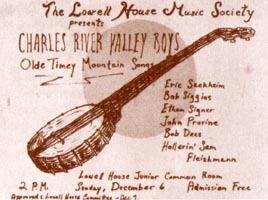
Dazzling Stranger
In 1961 Albert accepted another assignment from Unesco, to lead their
Division of Science Teaching in Paris. Off they went to Paris, Mr. and Mrs. Baez
and Mimi. Pauline had married, and Joan had her singing
career, so only Mimi still lived with her parents. In Paris she all but gave up public
education and was finishing up high school through correspondence courses, which
left her time to enjoy Paris. She starred in an experimental film by Peter
Robinson, a friend of her father, and the soundtrack was recorded
by Rolf Cahn, a guitarist they knew from Cambridge. She also continued to study
dance, and even toured with a ballet troupe in Germany.
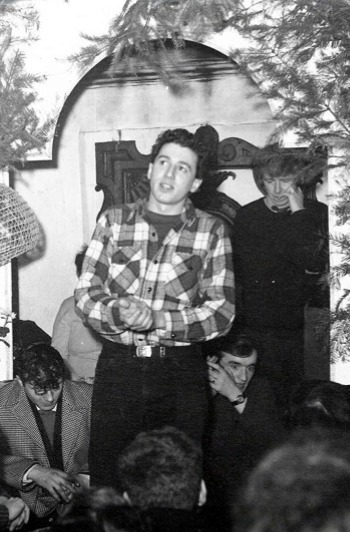
Richard Fariña at the Troubadour
Photo by Alison Chapman McLean
Photo by
Young girl, you chose the amber coil of a wish,
unlocked it with the cocking of a heel
and stepped away. While in the lunge of flight
I know the tale in your dark body's book.
Mimi and Richard moved in a one-room cabin near Joan's home in Carmel Valley.
Richard worked on his novel during the day, and at night they would entertain
themselves by making music. They began composing songs based
on a unique, polyrythmic and improvisational interplay of guitar and dulcimer, an
unusual combination that opened up
unknown musical territory as wild and beautiful as the Carmel countryside.
No doubt their music drew its uniqueness from the extensive travelling they had
done individually, each being exposed to a diversity of styles that gave
them an eclectic sophistication uncommon in American folk artists of the day.
Although their collaboration began only for their own entertainment, their sound was
so unique and infectious that everyone encouraged them to share it with the world.
Richard began writing lyrics, and Joan submitted some of them to Vanguard's
publishing company, Ryerson, who offered him a publishing contract.
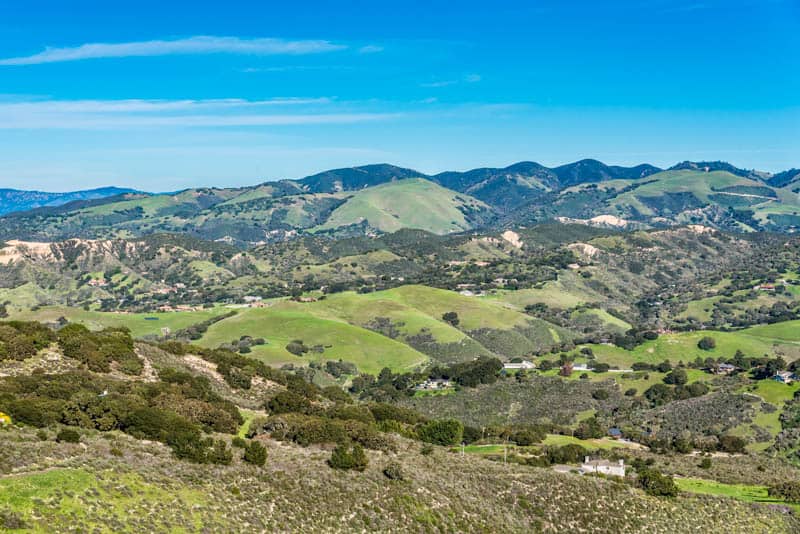
Carmel Valley, CA
"Well, any time you found Joan Baez, Richard and Mimi Fariña, and me in the same
place there had to be singing, so instead of meetings and lectures, sing we did,
in the sulphur baths, on the lawns, even during meals sitting at long wooden tables
in the lodge. Sunday afternoon we invited the neighborhood in general to join us,
turned the deck of the Esalen swimming pool into a stage, and sang to everyone."
Thus Nancy Carlen describes the first Big Sur Folk Festival. It was here that
Mimi and Dick Fariña debuted as a folk duo, playing the only three songs they had
practiced well enough to perform in public. But their short set was a hit: the
audience begged for more, and three different record companies, including folk
giants Vanguard and Elektra, offered them recording contracts. Since Richard
already had a publishing contract with Vanguard, they signed with Vanguard, which
had done so well for Joan.
That fall Mimi and Dick recorded their first album in Olmstead Studios in Manhattan,
with the aid of studio sessionman Bruce Langhorne, a guitar wizard and multi-instrumentalist
whom Richard had befriended during the recording of Carolyn Hester's album two
years earlier. Mimi and Dick were considering going back to Europe after recording
the album, but instead they moved to Cambridge, where each of them had lived before.
They rejoined old friends and met newcomers to the still growing
folk boom--Eric Andersen, Tom Rush, Paul Arnoldi, and others. Mimi and Dick, newcomers
themselves as a performing duo, began to play the myriad folk houses, The Rook, the Loft,
Club 47. But even among the increasing competition of the Cambridge scene, their
music rang out its unique charm, and they won several categories in the
Broadside of Boston annual readers poll.
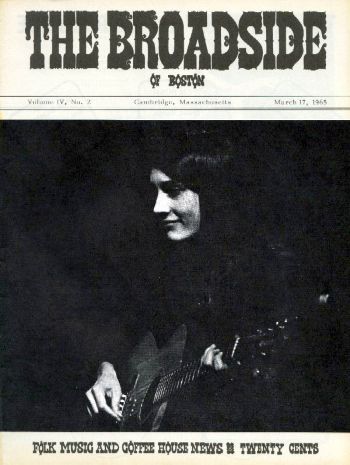
Broadside of Boston, March 17, 1965
"She contributed mightily to his development as a
musician, and if it weren't for Mimi and her knowledge
of music theory and her understanding of chords and
her own creativity Richard Fariña would never have
emerged a half-decent songwriter as he did, he would
never have had a moderately successful career as half
of a performing folk duo as he did with Mimi."
Late in 1967 Mimi joined an improvisational comedy troupe, The Committee. Founded
by Alan Myerson and Irene Riordan, who had been members of the Second City comedy
troupe in Chicago, The Committee was based in San Francisco and lasted from 1963
to 1973. Key Magazine described their act as "ingeniously clever barbed wit and satirical lampooning of
sacred cows, fetishes, political issues and timely topics." Mimi started as a fan
in The Committee's audience, but then,
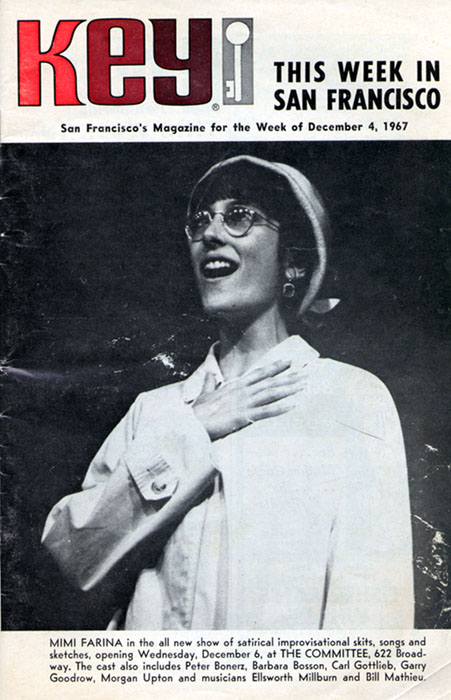
Mimi performs a skit with
The Committee
"I laughed so hard they asked me
to join them.... Dick loved the Committee and I think I was testing being him, as
if I had gained some of his energy when he died. I just thought, 'This is what I'm
supposed to be doing now.'"
Through The Committee Mimi made many friends, some of whom she
would remained connected to for years to come: Julia Payne, with whom she toured
briefly (there is a short clip of them playing together in Celebration at Big
Sur); Chris Ross, to whom she later dedicated the song "Reach Out;" and several
others who later dedicated their time to Bread & Roses, such as Carl Gottlieb,
Gary Goodrow, and David Ogden Steirs (later of M*A*S*H fame).
"Death that clouds her life will be forever
I do not know whether Mimi ever heard the song, but if she did she must have
perceived the references to her: the similarity of "Meagan" and "Mimi" and a host
of other personal allusions would have made it obvious. It was yet another
contribution to the hagiography of Mimi as the perpetual widow.
She is loved yet cannot love, not never."
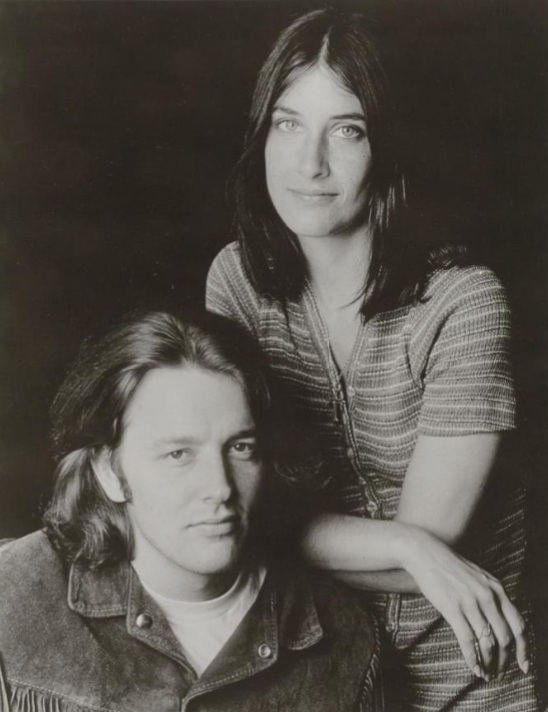 In 1970 Joan introduced Mimi to an aspiring singer-songwriter named
Tom Jans. Both had been writing songs and looking for a partner to perform with.
They first experimented as a trio including Julie Payne, with whom Mimi had
been performing. But Julie then decided to spend all her time acting, and Mimi
and Tom struck out as a duo. As luck would have it, they blended beautifully as
musicians and singers. As Tom reported in an interview,
In 1970 Joan introduced Mimi to an aspiring singer-songwriter named
Tom Jans. Both had been writing songs and looking for a partner to perform with.
They first experimented as a trio including Julie Payne, with whom Mimi had
been performing. But Julie then decided to spend all her time acting, and Mimi
and Tom struck out as a duo. As luck would have it, they blended beautifully as
musicians and singers. As Tom reported in an interview,
"I was singing by myself
in California, and Mimi was looking for someone to sing with.... I was singing
at a little club, and some people from the Institute of Nonviolence asked me to
come up and have dinner. That's when I met Joan and through Joan I met Mimi...
Mimi and I just started
singing, just at home kind of singing for friends, and suddenly...we were getting
calls from clubs--so we worked out a couple of songs."
Their first gig was at The Matrix in San Francisco, but their appearance at the
Big Sur Festival was regarded as their formal debut.
They signed with a relatively new independent label, A&M Records, whither Joan
had migrated after her ten-year run with Vanguard. Mimi and Tom recorded a
splendid
album, Take Heart, which included her most famous song, "In The
Quiet Morning," a requiem for Janis Joplin. Many feel that Take Heart features
some of Mimi's finest work. Mimi and Tom toured extensively in the United States and
Europe, and appeared on the Dick Cavett Show. They were a class act--
great singers and great guitarists who blended well and even wrote songs together.
But around May or June of 1972 they split up, for reasons never clearly documented.
"I don't think I've ever listened to an entire Dick and Mimi Fariña album...
I guess I resent the whole thing sometimes." "I don't feel that
way at all," said Mimi, staring intently at Tom. "Well, I'm not related to him,"
said Jans in a restrained way. "I mean he's not my brother or anything."
As if the challenge of living up to Dick's larger-than-life persona were not
daunting enough to begin with, Tom's partnership with Mimi also coincided with
something of a Richard Fariña Revival. During 1971, the year of Mimi and Tom's
debut, Vanguard released The Best of Mimi &
Richard Fariña; Paramount released a film adaptation of Been Down So Long It Looks Like Up
To Me; and a musical celebrating his life and art, Richard Fariña: Long
Time Coming and a Long Time Gone, ran in Boston and New York. Mimi herself was
involved with
the musical, collaborating with Joan, Judy Collins, and Richard's father. There
were even plans for Mimi and Mr. Farina to write a biography of Richard. Amid all
this attention to a deceased
legend, it's not surprising that Tom Jans felt the need to strike out on his own, lest the
shadow that seemed to loom over Mimi should overtake him as well. Tom released a
solo album of thoughtful rock music with A&M in 1974, and a few more albums
followed on Columbia in a fairly successful career.
"For me, that was an example of how somebody didn't treat someone else like a
human. I was looked on as a product.... I told him that I'd love to hear myself on
the radio, but it's not the aim of my life. I don't think they wanted me. They
wanted something they could package. If things got really difficult I don't know how far I would bend. I've got to make a
living. But this time I wouldn't bend far enough."
In the end, Mimi was released from her contract and the album disappeared into
oblivion. Or, as she good-humoredly described it, "I was released and the album
wasn't." Mimi salvaged a couple of the songs she had written, and recorded them
again with Joan for her 1973 album,
Where Are You Now, My Son? But the irony could not have been lost on Mimi:
Joan had the freedom to record her most controversial album ever, while Mimi's
career was faltering. The CBS memo releasing Mimi from her contract
had described her as "a marginal act," a label that enraged Mimi for years
to come. She became increasingly bitter about the music industry. With the growth
of the "arena rock" phenomenon in the early seventies, record companies began
to cast their greedy
eyes on bigger and bigger profits, squeezing out "smaller" artists and turning
rock stars into rich moguls who became disconnected
from their fans, their community, and their roots.
 The valiant work of Bread & Roses occupied most of Mimi's time from 1974
onwards, though she continue to appeared at folk festivals and made guest appearances
on various albums by friends of hers. But she never entirely let go of an ambition to validate herself
as a solo performer with a solo album.
By the late seventies Bread & Roses had earned Mimi a reputation independent of
Richard Fariña, Tom Jans, or her big
sister Joan. She had made a name for herself, and with renewed confidence she
started shopping around for a record contract again. She recorded an album for
Wolfgang, a label led by Bill Graham. An article in
CoEvolution Quarterly in 1978 announced
that it would be out in September under the title More Than A Charitable Act.
Unfortunately, the album never materialized, for reasons unknown.
The valiant work of Bread & Roses occupied most of Mimi's time from 1974
onwards, though she continue to appeared at folk festivals and made guest appearances
on various albums by friends of hers. But she never entirely let go of an ambition to validate herself
as a solo performer with a solo album.
By the late seventies Bread & Roses had earned Mimi a reputation independent of
Richard Fariña, Tom Jans, or her big
sister Joan. She had made a name for herself, and with renewed confidence she
started shopping around for a record contract again. She recorded an album for
Wolfgang, a label led by Bill Graham. An article in
CoEvolution Quarterly in 1978 announced
that it would be out in September under the title More Than A Charitable Act.
Unfortunately, the album never materialized, for reasons unknown.
"After many years of putting my music career in second place and choosing to devote
most of my time to the non-profit world, I am pleased to announce that soon I will
be releasing my first solo album. No, I won't be leaving Bread & Roses; it still brings
joy and purpose to the lives of many, including my own. But I do intend to share
more of my time between music and what Tom Paxton refers to as one's "day gig".
An office structure provides a stability for me that is often missing in an
entertainer's lifestyle. But don't misunderstand: I'd never refuse a limo ride, or
a standing ovation.
Mimi toured extensively in the mid-eighties but seems to have stopped around 1988.
She must have realized at some point that Bread & Roses was her true calling, her
life's work. In retrospect it seems as if her entire life uniquely prepared her for
this mission: her Quaker upbringing, her parents' politics, her
early experiences as a young child in Baghdad, which inspired her passion for
social justice; her constant moving, which gave her a distaste for travel and a
fondness for the creature comforts of home; her deeply conflicted feelings toward
the musician's life, which bred her cynicism for the industry yet also a fervent
belief in music's healing power. Perhaps the most determining factor of all was her role
as the youngest daughter in the family. Perhaps I am biased because I too am the
youngest child, but it seems to me that her little-sister relationship with Joan
patterned her relationship with Richard and to a lesser extent her entire approach
to life. She never sought fame, had no interest in it; and yet Joan Baez and
Richard Fariña were the dazzling sun and mysterious moon that brought such
strange and ironic experiences upon her. The unique path she walked
deepened her compassion for the marginalized, the outcast, the left behind, and sparked a
desire to make their world a little brighter.
farinaweb@yahoo.com
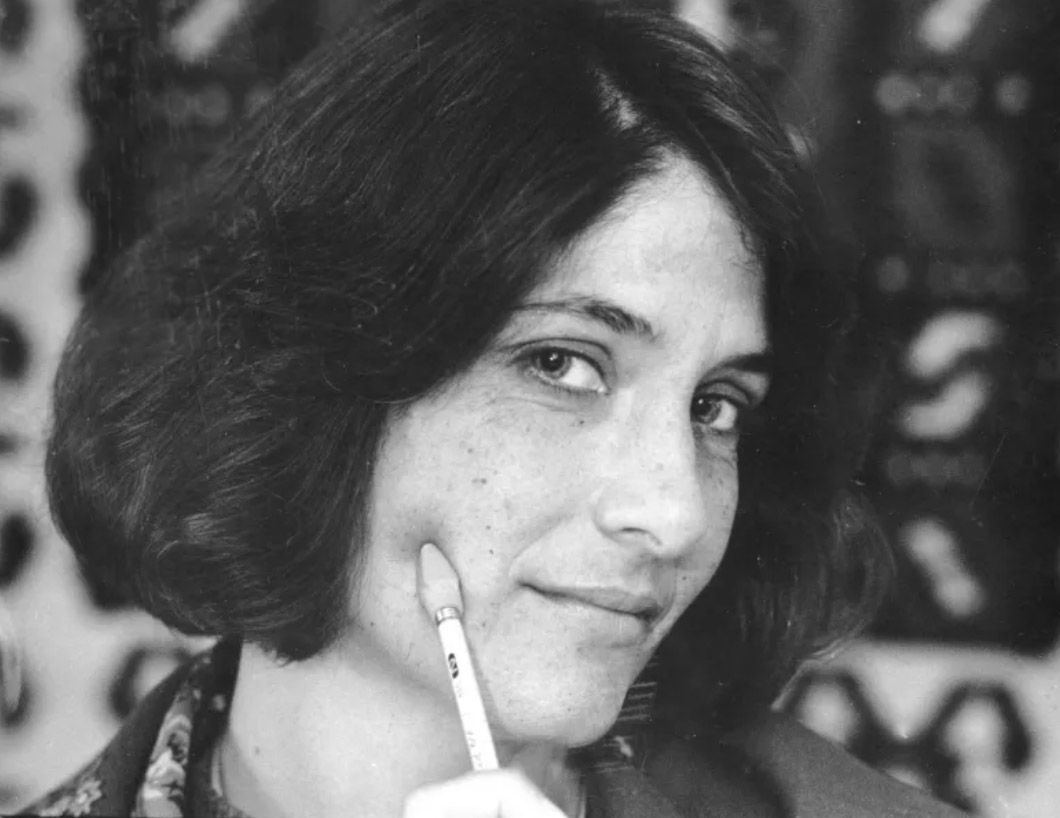
Mimi in 1984, photo by Tom Strickland
Back to Mimi's page.
Back to the Richard & Mimi Fariña homepage.